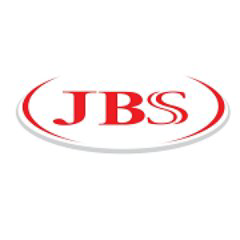JBS SA (JBSAY) Q2 2024 Earnings Call Highlights: Strong Revenue Growth and Improved Margins


Net Revenue: USD 19.3 billion for the second quarter of 2024.
Consolidated EBITDA Margin: 9.8%, an increase of 5 percentage points compared to Q2 2023.
Adjusted EBITDA: USD 1.9 billion.
Free Cash Flow: USD 1.1 billion.
Net Income: USD 329 million.
Adjusted Net Profit: USD 470 million, after adding back non-recurring effects.
US Pork Margin: Increased from 4.4% to 11.1% year over year.
Pilgrim's Pride EBITDA: USD 782.8 million, with a margin of 17.2%.
Seara EBITDA Margin: 17.4%.
CapEx Expenditure: Approximately USD 346 million, 63% for maintenance.
Net Debt: USD 14.8 billion, a reduction of USD 1.1 billion from the previous quarter.
Leverage Ratio: Decreased from 3.66 times to 2.77 times in the second quarter.
Interim Dividends: USD 0.37 per share announced.
Seara Net Revenue Growth: 6.7% year over year.
JBS Brazil Net Revenue Growth: 5% higher than Q2 2023.
JBS USA Pork Net Revenue: 22% higher than Q2 2023.
Pilgrim's Pride Net Revenue Growth: 6% increase compared to Q2 2023.
Release Date: August 14, 2024
For the complete transcript of the earnings call, please refer to the full earnings call transcript.
Positive Points
JBS SA (JBSAY) reported a strong second quarter with net revenue of USD19.3 billion and a consolidated EBITDA margin of 9.8%, up 5 percentage points from the previous year.
The company generated a positive free cash flow of USD1.1 billion and announced a dividend distribution of USD0.37 per share.
JBS SA's global multi-protein platform, particularly its poultry and pork operations, contributed 75% of the EBITDA, showcasing the effectiveness of its diversification strategy.
The US pork division saw a significant margin increase from 4.4% to 11.1% year over year, driven by operational improvements and favorable market conditions.
The company's leverage ratio decreased from 3.66 times to 2.77 times in one quarter, indicating strong financial management and a path towards further deleveraging.
Negative Points
JBS Beef North America faced challenges due to a difficult cattle cycle, impacting profitability despite increased revenue.
The company is still navigating export restrictions due to the Newcastle disease outbreak, which could impact future quarters.
Despite strong results, the market environment in the United States remains challenging, particularly for the beef business.
The company is experiencing volatility in treasury markets, which could affect future financial strategies.
The NYSE listing process is ongoing and subject to delays, which could impact investor sentiment and market positioning.
Q & A Highlights
Q: Can you explain the significant improvement in Seara's margins from 1% to 17%? How much was due to operational efficiencies versus market conditions like lower grain costs? A: Gilberto Tomazoni, CEO, explained that the improvement was due to both operational efficiencies and market conditions. They improved agricultural and production operations, factory productivity, and commercial processes. He estimated that about half of the improvement was due to operational enhancements and the other half to lower grain costs.
Q: How is the Newcastle disease outbreak affecting Seara, and what is the outlook for the third quarter? A: Tomazoni noted that while there is an impact, it is not significant. The Brazilian government acted quickly, and JBS managed the situation efficiently by shifting production to other approved plants. The impact on results is expected to be minimal.
Q: What drove the significant margin improvement in US pork, reaching 12.5%? A: Wesley Batista Filho, CEO of JBS Foods USA, attributed the improvement to favorable market conditions, such as low grain prices and strong demand for pork as an alternative to high-priced beef. Additionally, JBS's investments in prepared foods and efficient operations contributed to the strong performance.
Q: How is JBS addressing the strong domestic demand for protein in Brazil, and do you expect this demand to continue into 2025? A: Tomazoni expressed optimism about domestic demand in Brazil, citing increased cattle processing and per capita consumption. JBS is investing in new products and capacity to meet demand, focusing on consumer preference rather than just price competition.
Q: What is the impact of lower grain costs on JBS's margins, and what is the outlook for grain costs into 2025? A: Tomazoni highlighted the importance of balancing supply and demand. With good crop forecasts and stable grain prices, JBS expects to maintain strong results. The balance between supply and demand is crucial for continued success.
For the complete transcript of the earnings call, please refer to the full earnings call transcript.
This article first appeared on GuruFocus.